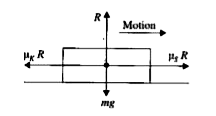The coefficients of static and dynamic friction are 0.7 and 0.4. The minimum force required to create motion is applied on a body and if it is further continued, the acceleration attained by the body in is
7
4
3
Zero
The correct Answer is:C
Topper's Solved these Questions
- LAW OF MOTIONBOOK - NARAYNACHAPTER - LAW OF MOTIONEXERCISE - EXERCISE - I (C.W)(MOTION ON A HORIZONTAL ROUGH SURFACE)
8 Videos
- LAW OF MOTIONBOOK - NARAYNACHAPTER - LAW OF MOTIONEXERCISE - EXERCISE - I (C.W)(MOTION OF A BODY ON THE INCLINED PLANE)
7 Videos
- LAW OF MOTIONBOOK - NARAYNACHAPTER - LAW OF MOTIONEXERCISE - EXERCISE - I (C.W)(EQUILIBRIUM OF A PARTICLE)
2 Videos
- KINETIC THEORY OF GASESBOOK - NARAYNACHAPTER - KINETIC THEORY OF GASESEXERCISE - LEVEL-III(C.W)
52 Videos
- MATHEMATICAL REVIEW & PHYSICAL WORLDBOOK - NARAYNACHAPTER - MATHEMATICAL REVIEW & PHYSICAL WORLDEXERCISE - C.U.Q
13 Videos
Similar Questions
The co-efficient of static & kinetic friction are 0.6 & 0.3 The minimum horizontal force required to start the motion is applied and if it is continued, the distance travelled by the body in 4 sec is (g=10 ms−2)
View SolutionA block of mass 2 kg is on a horizontal surface. The coefficient of static & kinetic frictions are 0.6 & 0.2 The minimum horizontal force required to start the motion is applied and if it is continued, the velocity acquired by the body at the end of the 2nd second is (g=10ms2)
View Solution
Knowledge Check
A horizontal force just sufficient to move a body of mass 4kg lying on a rought horizontal surface is applied on it .The coefficient of static and kinetic friction the body and the surface are 0.8and0.6 respectively If the force contines to act even after the block has started moving the acceleration of the block in ms−2 is (g=10ms−2)
A14B12C2D4For a body on a horizontal surface, coefficients of static and kinetic frictions are 0.4 and 0.2 respectively. When the body is in uniform motion on the surface, a horizontal force equal in magnitude to limiting friction is applied on it. The acceleration produced is
 A0.4gB0.1 gC0.2 gD0.6 g
A0.4gB0.1 gC0.2 gD0.6 gThe block of mass 4kg is placed on a rough horizontal surface having the coefficient of kinetic and static friction as 0.4 and 0.5 respectively. If a force of 4N is applied to the body, then the frictional force acting on the body will be [g=ms2]
A20NB10NC4ND8N
The coefficient of static and dynamic friction between a body and the surface are 0.75 and 0.5 respectively. A force is applied to the body to make it just slide with a constant acceleration which is
View SolutionFind the force required to move a train of mass 5000 quintal up an incline of 1 in 50 with an acceleration of 2m/s2 Take force of friction = 0.2 N quintal and g=10ms−2.
View SolutionA body of mass 2 kg is placed on a horizontal surface having coefficient of kinetic friction 0.4 and limiting coefficient of static friction 0.5. If a horizontal force 2.5 N is applied on the body, the frictional force acting on the body will be (Take, g=10ms2)
View SolutionA body of mass 40kg resting on a rough horizontal surface is subjected to a force P which is just enough to start the motion of the body. If μs=0.5μk=0.4,g=10ms−2 an dthe force P is continuously applied on the body, then the accceleration of the body is.
View SolutionA body of mass 2 kg is placed on a horizontal surface having kinetic friction 0.4 and static friction 0.5. If the force applied on the body is 2.5 N, then the frictional force acting on the body will be
View Solution
